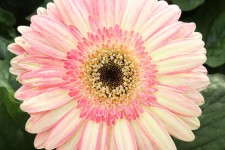New Gerberas Offer Options For Containers, Bedding And Cut Flowers

Gerbera has been a favorite flower for decades, and its popularity continues to grow.
Discovered in South Africa in 1884, gerbera (Gerbera jamesonii) was named after the German botanist Traugott Gerber. It was first cultivated in England in the 1890s, and was originally brought to market by florists as a potted crop meant to draw customers into their stores.
Today, gerbera is one of the five most popular flowers behind roses, carnations, chrysanthemums and tulips. It has grown into a multi-purpose plant that is coveted for containers, bedding designs and cut flowers, and it has evolved from its traditional roots to a modern beauty
with a twist.
Cut Flowers Vs. Potted
Primarily grown in the Netherlands and Colombia, cut flower gerbera are commonly used in floral arrangements. Unlike the older varieties, these gerbera are produced from tissue-cultured plants and are grown in specialty production facilities. These facilities are especially suited for cultivating plants with thicker, longer stems that produce a continual
harvest of cut flowers.
Bred to stand out and brighten any garden, bedding gerbera have short, sturdy stems that produce three to five flowers at first flush. They bloom throughout the season, providing continual color that will pop at retail. Their compact growth habit and manageable foliage allow growers to increase their profitability by growing more plants per square foot and maximizing shipping rack space.
Consumers in the warmest parts of the country, Zones 9 to 11, will see gerbera last throughout the winter season, while the rest of the country will see beautiful annuals in the landscape through the summer and into the fall.
More than 100 years after being discovered, varieties suited for potted gerbera have been subject to the greatest evolution. Once a delightful classic with core colors, the potted gerbera has transformed from a flower seen only in florist shops to a modern, diverse plant that is sold in premium containers alongside other bedding plants. They have been bred to be more vigorous with bloom sizes ranging from mini to extra-large. These potted gerbera are a high-quality blooming potted plant that growers can produce in large quantities and demand a premium price.
Modern breeding has also brought consumers a rainbow of novelty colors to choose from beyond the classic red, yellow and white. For example, the latest gerbera innovation from Syngenta Flowers showcases this potential for unique colors that consumers love. Gerbera ‘Cartwheel Strawberry Twist’ is a segregating genetic that brings various flower colors and shading to each plant. The flowers can vary from plant to plant, producing a range of colors from buttery yellows with a hint of pink to deep strawberry with a hint of yellow and everything in between.
With more choices in plant type, color and habit, growers have a wide variety to choose from. Each gerbera type is ideal for different markets and can fit the needs of different retailers.
Trends In Breeding
When choosing a variety to grow, it is important to know the current breeding and consumer trends. Over the past few decades, consumers have started choosing container varieties over landscape varieties, which may be influenced by limitations of space in urban areas. Consumers tend to be drawn to plants with larger blooms, more flowers and unique colors. They are also prone to choose plants that are easy to maintain and can be mixed with other ornamentals to make the perfect designer combinations.
The evolutions seen in gerbera breeding not only satisfy consumer desires, but also improve production and profitability for growers. Historically, quality gerbera were started from tissue-culture liners, which came at a lofty expense. However, with the advances in seed breeding, gerbera can now be propagated from seed and result in high-quality plants at a lower cost to growers.
Recently, breeding companies have also sought ways to help growers produce gerbera more efficiently. Many gerbera varieties are now available in coated seed, which allows it to flow easily through modern seeders. Using coated varieties also makes seed more visible in plug
trays, helping to ensure that seeds are not accidentally multi-sown into a single plug cell. This will ultimately save costs for the grower.
Technical Advances
In addition to progressive breeding, advances in technical support are making gerbera easier to grow today than ever before. By managing the growing environment and controlling insects and diseases, growers are having great success producing this profitable plant. Additionally, most gerbera breeding companies provide production assistance, culture guides and plant protection options.
Gerbera has come a long way from its humble beginnings. The increasing popularity of this crop has led to more breeding advances and given growers more options for producing gerbera. Whether it is grown for beautiful cut flower bouquets or for beds and containers, gerbera is a great choice to give consumers tradition with a twist. GG










